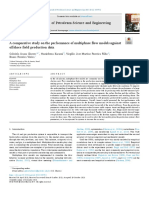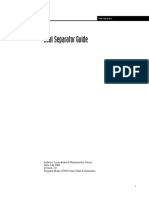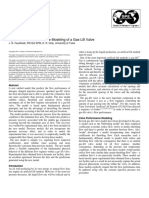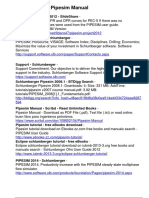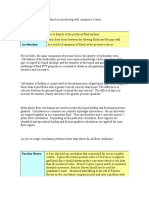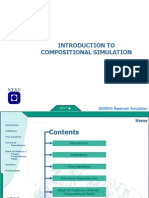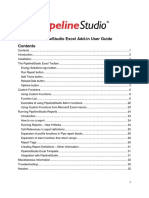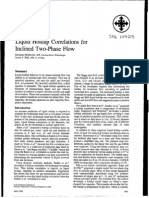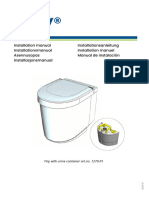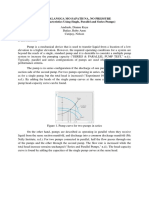Flow Correlation Selection
Flow Correlation Selection
Uploaded by
Hamza AliCopyright:
Available Formats
Flow Correlation Selection
Flow Correlation Selection
Uploaded by
Hamza AliOriginal Description:
Copyright
Available Formats
Share this document
Did you find this document useful?
Is this content inappropriate?
Copyright:
Available Formats
Flow Correlation Selection
Flow Correlation Selection
Uploaded by
Hamza AliCopyright:
Available Formats
j:\documents and settings\mack
shippen\desktop\flow correlations.doc
24th October 1997 - Revision: 0 Page 1 of 14
Information on Flow Correlations used within PIPESIM
CONTENTS
1. TWO-PHASE FLOW CORRELATIONS .............................................................................................. 2
1.1. APPLICABILITY.......................................................................................................................................... 2
1.2. DESCRIPTION OF CORRELATIONS............................................................................................................... 2
1.2.1. Duns & Ros
[4]
................................................................................................................................... 2
1.2.2. Orkiszewski
[11]
.................................................................................................................................. 2
1.2.3. Hagedorn & Brown
[7]
....................................................................................................................... 3
1.2.4. Beggs & Brill Original
[2]
.................................................................................................................. 3
1.2.5. Beggs & Brill Revised
[2]
................................................................................................................... 3
1.2.6. Mukherjee & Brill
[18]
........................................................................................................................ 3
1.2.7. Govier, Aziz & Fogarasi
[1]
............................................................................................................... 3
1.2.8. NoSlip ............................................................................................................................................... 4
1.2.9. OLGAS-89
[24]
.................................................................................................................................... 4
1.2.10. OLGAS-92
[24]
.................................................................................................................................. 4
1.2.11. Ansari
[20]
......................................................................................................................................... 4
1.2.12. BJA for Condensates
[22]
.................................................................................................................. 4
1.2.13. AGA & Flanigan
[3]&[6]
.................................................................................................................... 4
1.2.14. Oliemans
[10]
.................................................................................................................................... 5
1.2.15. Gray
[23]
........................................................................................................................................... 5
1.2.16. Xiao
[21]
............................................................................................................................................ 5
1.3. MATCHING STUDY..................................................................................................................................... 5
1.3.1. Overview of Analysis Work............................................................................................................... 5
1.3.2. Method of Analysis ........................................................................................................................... 7
1.3.3. Overall Performance of Correlations............................................................................................... 8
2. SINGLE PHASE FLOW CORRELATIONS ....................................................................................... 10
2.1. APPLICABILITY........................................................................................................................................ 10
2.2. RECOMMENDATION ................................................................................................................................. 10
3. SLUG CORRELATIONS....................................................................................................................... 10
4. REFERENCES ........................................................................................................................................ 12
j:\documents and settings\mack
shippen\desktop\flow correlations.doc
24th October 1997 - Revision: 0 Page 2 of 14
1. TWO-PHASE FLOW CORRELATIONS
1.1. Applicability
The two-phase flow correlations can be used as follows:-
Vertical and
Predominantly
Vertical Oil
Wells
Highly
Deviated
Oil Wells
Vertical Gas/
Condensate
Wells
Oil
Pipelines
Gas/
Condensate
Pipelines
Duns & Ros
Orkiszewski
Hagedorn & Brown
Beggs & Brill Revised
Beggs & Brill Original
Mukherjee & Brill
Govier, Aziz & Fogarasi
NoSlip
OLGAS-89
OLGAS-92
Ansari
BJA for Condensates
AGA & Flanigan
Oliemans
Gray
Xiao
1.2. Description of Correlations
1.2.1. Duns & Ros
[4]
The Duns & Ros correlation was developed for vertical flow of gas and liquid mixtures
in wells. Equations were developed for each of three flow regions, (I) bubble, plug and
part of froth flow regimes, (II) remainder of froth flow and slug flow regimes, (III) mist
flow regime. These regions have low, intermediate and high gas throughputs respectively.
Each flow region has a different holdup correlation. The equations were based on
extensive experimental work using oil and air mixtures.
1.2.2. Orkiszewski
[11]
The Orkiszewski correlation was developed for the prediction of two phase pressure
drops in vertical pipe. Four flow regimes were considered, bubble, slug, annular-slug
transition, and annular mist. The method can accurately predict, to within 10%, the two
phase pressure drops in naturally flowing and gas lifted production wells over a wide
range of well conditions. The precision of the method was verified when its predicted
values were compared against 148 measured pressure drops. Unlike most other methods,
liquid holdup is derived from observed physical phenomena, and is adjusted for angle of
deviation.
j:\documents and settings\mack
shippen\desktop\flow correlations.doc
24th October 1997 - Revision: 0 Page 3 of 14
1.2.3. Hagedorn & Brown
[7]
The Hagedorn and Brown correlation was developed following an experimental study of
pressure gradients occurring during continuous two-phase flow in small diameter
vertical conduits. A 1,500 ft experimental well was used to study flow through 1, 1,
and 1 nominal size tubing. Tests were conducted for widely varying liquid flowrates,
gas-liquid ratios and liquid viscosities. All of the correlations involve only dimensionless
groups, which is a condition usually sought for in similarity analysis but not always
achieved.
1.2.4. Beggs & Brill Original
[2]
The Beggs & Brill correlation was developed following a study of two-phase flow in
horizontal and inclined pipes. The correlation is based upon a flow regime map which is
first determined as if the flow was horizontal. A horizontal holdup is then calculated by
correlations, and this holdup is corrected for the angle of inclination. The test system
included two 90 ft long acrylic pipes, winched to a variable elevation in the middle, so as
to model incline flow both upwards and downwards at angles of up to 90.
1.2.5. Beggs & Brill Revised
[2]
The following enhancements to the original method are used; (1) an extra flow regime of
froth flow is considered which assumes a no-slip holdup, (2) the friction factor is changed
from the standard smooth pipe model, to utilise a single phase friction factor based on the
average fluid velocity.
1.2.6. Mukherjee & Brill
[18]
The Mukherjee & Brill correlation was developed following a study of pressure drop
behaviour in two-phase inclined flow. For bubble and slug flow, a no-slip friction factor
calculated from the Moody diagram was found adequate for friction head loss
calculations. In downhill stratified flow, the friction pressure gradient is calculated based
on a momentum balance equation for either phase assuming a smooth gas-liquid
interface. For annular-mist flow, a friction factor correlation was presented that is a
function of holdup ratio and no-slip Moody friction factor. Results agreed well with the
experimental data and correlations were further verified with Prudhoe Bay and North Sea
data.
1.2.7. Govier, Aziz & Fogarasi
[1]
The Govier, Aziz & Fogarasi correlation was developed following a study of pressure
drop in wells producing gas and condensate. Actual field pressure drop v. flowrate data
from 102 wells with gas-liquid ratios ranging from 3,900 to 1,170,000 scf/bbl were
analysed in detail. The phase conditions in the well bore were determined by standard
flash calculations. Pressure-gradient data for flow under single-phase conditions were
compared with conventional predictions, and found generally to confirm them. For the
test in which two-phase conditions were predicted throughout the well bore, the field data
were compared with several wholly empirical prediction methods, with a previously
proposed method, and with a new prediction method partly based on the mechanics of
flow. The new prediction method incorporates an empirical estimate of the distribution of
the liquid phase between that flowing as a film on the wall and that entrained in the gas
core. It employs separate momentum equations for the gas-liquid mixture in the core and
for the total contents of the pipe.
j:\documents and settings\mack
shippen\desktop\flow correlations.doc
24th October 1997 - Revision: 0 Page 4 of 14
1.2.8. NoSlip
The NoSlip correlation assumes homogeneous flow with no slippage between the phases.
Fluid properties are taken as the average of the gas and liquid phases and friction factors
are calculated using the single phase Moody correlation.
1.2.9. OLGAS-89
[24]
OLGAS is based in larger part on data from the SINTEF two-phase flow laboratory near
Trondheim, Norway. The test facilities were designed to operate at conditions that
approximated field conditions. The test loop was 800m long and of 8 diameter.
Operating pressures between 20 and 90 barg were studied. Gas superficial velocities of up
to 13 m/s, and liquid superficial velocities of up to 4 m/s were obtained. In order to
simulate the range of viscosities and surface tensions experienced in field applications,
different hydrocarbon liquids were used (naptha, diesel, and lube oil). Nitrogen was used
as the gas. Pipeline inclination angles between 1 were studied in addition to flow up or
down a hill section ahead of a 50m high vertical riser. Over 10,000 experiments were run
on this test loop during an eight year period. The facility was run in both steady state and
transient modes. OLGAS considers four flow regimes, stratified, annular, slug and
dispersed bubble flow and uses a unique minimum slip criteria to predict flow regime
transitions.
1.2.10. OLGAS-92
[24]
This is a revision of OLGAS-89
1.2.11. Ansari
[20]
The Ansari model was developed as part of the Tulsa University Fluid Flow Projects
(TUFFP) research program. A comprehensive model was formulated to predict flow
patterns and the flow characteristics of the predicted flow patterns for upward two-phase
flow. The comprehensive mechanistic model is composed of a model for flow pattern
prediction and a set of independent models for predicting holdup and pressure drop in
bubble, slug, and annular flows. The model was evaluated by using the TUFFP well
databank that is composed of 1775 well cases, with 371 of them from Prudhoe Bay data.
1.2.12. BJA for Condensates
[22]
Baker Jardine & Associates have developed a correlation for two phase flow in gas-
condensate pipelines with a no-slip liquid volume fraction of lower than 0.1. This
model represents no major advance in theory, but rather a consolidation of various
existing mechanistic models, combined with a modest amount of theoretical development
and field data testing. The model uses the Taitel Dukler flow regime map and a modified
set of the Taitel Dukler momentum balance to predict liquid holdup. The pressure loss
calculation procedure is similar in approach to that proposed by Oliemans, but accounts
for the increased interfacial shear resulting from the liquid surface roughness.
1.2.13. AGA & Flanigan
[3]&[6]
The AGA & Flanigan correlation was developed for horizontal and inclined two phase
flow of gas-condensate gathering systems. The Taitel Dukler flow regime map is used
which considers five flow regimes, stratified smooth, stratified wavy, intermittent,
annular dispersed liquid, and dispersed bubble. The Dukler equation is used to calculate
j:\documents and settings\mack
shippen\desktop\flow correlations.doc
24th October 1997 - Revision: 0 Page 5 of 15
the frictional pressure loss and holdup, and the Flanigan equation is used to calculate the
elevational pressure differential.
1.2.14. Oliemans
[10]
The Oliemans correlation was developed following the study of large diameter
condensate pipelines. The flow regime is predicted using the Taitel Dukler flow regime
map, and a simple model, which obeyed the correct single phase flow limits was
introduced to predict the pressure drop. The model was based on a limited amount of data
from a 30, 100 km pipeline operating at pressures of 100 barg or higher.
1.2.15. Gray
[23]
This correlation was developed by H E Gray of Shell Oil Company for vertical flow in
gas and condensate systems which are predominantly gas phase. Flow is treated as
single phase, and dropped out water or condensate is assumed to adhere to the pipe wall.
It is considered applicable for vertical flow cases where the velocity is below 50 ft/s, the
tube size is below 3, the condensate ratio is below 50 bbl/mmscf, and the water ratio is
below 5 bbl/mmscf.
1.2.16. Xiao
[21]
The Xiao comprehensive mechanistic model was developed as part of the TUFFP
research program. It was developed for gas-liquid two-phase flow in horizontal and
near horizontal pipelines. The model is able first to detect the existing flow pattern, and
then to predict the flow characteristics, primarily liquid holdup and pressure drop, for the
stratified, intermittent, annular, or dispersed bubble flow patterns. The model was tested
against a pipeline data bank. The data bank included large diameter field data culled from
the AGA multiphase pipeline data bank, and laboratory data published in literature. Data
included both black oil and compositional fluid systems. A new correlation was proposed
which predicts the internal friction factor under stratified flow.
1.3. Matching Study
Baker Jardine conducted a major data matching study to identify the most suitable two
phase flow correlations for each category of problem.
1.3.1. Overview of Analysis Work
Typically each dataset had around 10 data points. The following volume and range of
data was analysed:-
j:\documents and settings\mack
shippen\desktop\flow correlations.doc
24th October 1997 - Revision: 0 Page 6 of 14
Oil Wells
Number of Fields 8
Number of Wells 35
Range of Well Depth (feet) 1,782 - 10,007
Range of Nominal Tubing Diameter (inches) 2.5 - 7
Range of Mean Deviation Angle (degrees) 0 - 49
Range of Gross Liquid Flowrate (STbbl/day) 199 - 16,726
Range of Downhole Pressure (psia) 848 - 4,194
Range of Wellhead Pressure (psia) 98.5 - 956
Range of Bottom Hole Temperature (F) 86 - 254
Range of Watercut (%) 0.1 - 98.55
Range of GOR (Scf/STbbl) 60 - 1,077
Range of API 20.7 - 41
Range of Lift Gas Flowrate (MMScf/day) 0 - 4.89
Condensate Wells
Number of Fields 2
Number of Wells 3
Range of Well Depth (feet) 11,560 - 17,710
Range of Nominal Tubing Diameter (inches) 3 - 4.5
Range of Mean Deviation Angle (degrees) 0
Range of Gas Flowrate (MMScf/day) 3.78 - 18.06
Range of Downhole Pressure (psia) 2,032 - 14,228
Range of Wellhead Pressure (psia) 1,213 - 9,649
Range of Bottom Hole Temperature (F) 202 - 377
Range of Watercut (%) 0 - 3
Range of GOR (Scf/STbbl) 5,149 - 10,831
Oil Pipelines
Number of Pipelines 4
Range of Pipeline Length (miles) 0.97- 8
Pipeline Diameters (inches) 6
Range of Gross Liquid Flowrate (STbbl/day) 2,189 - 11,588
Range of Inlet Pressure (psia) 439 - 1,734
Range of Outlet Pressure (psia) 258 - 1,415
Range of Inlet Temperature (F) 77 - 162
Range of Watercut (%) 0 - 12.3
Range of GOR (Scf/STbbl) 248 - 1,545
Range of API 21.5 - 39.4
Range of Gas Flowrate (MMScf/day) 1.98 - 10.29
j:\documents and settings\mack
shippen\desktop\flow correlations.doc
24th October 1997 - Revision: 0 Page 7 of 14
Gas/Condensate Pipelines
Number of Pipelines 3
Range of Pipeline Length (miles) 38 - 226
Range of Pipeline Diameter (inches) 20 - 32
Range of Gross Liquid Flowrate (STbbl/day) 0 - 1,521
Range of Inlet Pressure (psia) 848 - 2,103
Range of Outlet Pressure (psia) 272 - 1,291
Range of Inlet Temperature (F) 70 - 117
Watercuts (%) 0
Range of GOR (Scf/STbbl) 24,400 - 1,250,000
Range of API 51 - 70
Range of Gas Flowrate (MMScf/day) 37.8 - 1,116
1.3.2. Method of Analysis
Each data point was individually modelled using the various correlations which have
been built into Baker Jardines steady state simulation program PIPESIM. The entered
values were obtained from well/pipeline tests, reservoir fluid analysis, and drilling
surveys/pipeline measurements.
For wells, the flow of fluid was modelled from the bottom hole to the well head where
possible. In some cases the flowing bottom hole pressure was not available, and in those
circumstances, the flow was modelled from the reservoir to the well head using a straight
line productivity index which had been estimated by the operator.
Similarly, pipelines were modelled using a reference inlet and outlet point.
In the case of dP prediction, the bottom hole (or reservoir), or pipeline inlet pressure was
calculated, and the calculated pressure drop (dPcalc = predicted inlet pressure - measured
outlet pressure) was compared to the measured pressure drop (dPmeas = measured inlet
pressure - measured outlet pressure). The %error for each point was then calculated as
follows:-
%error = ((dPcalc- dPmeas)/dPmeas) x 100%
The mean and standard deviation of this %error were calculated for each data set and the
correlations were rated in accordance with the following table:-
Designation Error Range (%) Maximum Standard Deviation (%)
Very Good -5.0 to +5.0 5.0
Good -10.0 to +10.0 10.0
Moderate -20.0 to +20.0 10.0
Poor Outside of the above error ranges
In the case of flowrate prediction, the measured pressure values were entered, and the
flowrate was solved by iteration. The predicted flowrate was then compared to the
measured flowrate. The % error for each point was then calculated as follows:-
j:\documents and settings\mack
shippen\desktop\flow correlations.doc
24th October 1997 - Revision: 0 Page 8 of 15
% error = ((Fcalc - Fmeas)/Fmeas) x 100%
The mean and standard deviation of this %error were calculated for each data set and the
correlations were rated in accordance with the following table:-
Designation Error Range (%) Maximum Standard Deviation (%)
Very Good -5.0 to +5.0 5.0
Good -10.0 to +10.0 10.0
Moderate -20.0 to +20.0 10.0
Poor Outside of the above error ranges
Failed For at least one data point, the correlation fails to
converge.
1.3.3. Overall Performance of Correlations
Values were assigned to each correlation in each dataset as follows:-
Very Good 3 points
Good 2 points
Moderate 0 points
Poor or Failed -3 points
The maximum score attainable is therefore 3 x (number of datasets) and this was awarded
100%. The minimum score attainable is -3 x (number of datasets) and this was awarded
0%. Otherwise, linear interpolation was used. The overall scores for dP prediction and
flowrate prediction were then averaged for each correlation, and the correlations sorted in
descending order of performance as shown below.
Vertical and Predominantly Vertical Oil Wells
Number of datasets = 33
Correlation Score %
Hagedorn & Brown 84
OLGAS-89 83
Ansari 81
OLGAS-92 81
Duns & Ros 80
NoSlip 80
Orkiszewski 76
Beggs & Brill Revised 73
Beggs & Brill Original 71
Mukherjee & Brill 70
Govier, Aziz & Fogarasi 59
j:\documents and settings\mack
shippen\desktop\flow correlations.doc
24th October 1997 - Revision: 0 Page 9 of 14
Highly Deviated Oil Wells
Number of datasets = 2
Correlation Score %
Duns & Ros 96
OLGAS-89 96
OLGAS-92 96
Beggs & Brill Original 88
Beggs & Brill Revised 79
NoSlip 79
Mukherjee & Brill 71
Govier, Aziz & Fogarasi 63
Gas/Condensate Wells
Number of datasets = 3
Correlation Score %
Hagedorn & Brown 47
NoSlip 47
OLGAS-89 47
Gray 42
OLGAS-92 42
Mukherjee & Brill 28
Beggs & Brill Original 17
Duns & Ros 17
Ansari 14
BJA for Condensates 8
Govier, Aziz & Fogarasi 8
Orkiszewski 8
Beggs & Brill Revised 0
Oil Pipelines
Number of datasets = 4
Correlation Score %
Oliemans 46
NoSlip 38
Mukherjee & Brill 35
Beggs & Brill Revised 29
Duns & Ros 25
OLGAS-89 23
OLGAS-92 21
Xiao 21
Beggs & Brill Original 13
Govier, Aziz & Fogarasi 13
AGA & Flanigan 0
BJA for Condensates 0
j:\documents and settings\mack
shippen\desktop\flow correlations.doc
24th October 1997 - Revision: 0 Page 10 of 15
Gas/Condensate Pipelines
Number of datasets = 3
Correlation Score %
BJA for Condensates 67
AGA & Flanigan 64
OLGAS-89 64
OLGAS-92 64
Xiao 64
Mukherjee & Brill 61
Oliemans 61
Beggs & Brill Revised 56
Govier, Aziz & Fogarasi 56
NoSlip 56
Beggs & Brill Original 42
Duns & Ros 33
2. SINGLE PHASE FLOW CORRELATIONS
2.1. Applicability
Single phase flow correlations can be used as follows:-
Vertical Oil
Flow
Horizontal
Oil Flow
Vertical Gas
Flow
Horizontal
Gas Flow
Moody
AGA
Panhandle A
Panhandle B
Hazen Williams
Weymouth
2.2. Recommendation
Moody is the recommended correlation for all single phase applications.
3. SLUG CORRELATIONS
The slug sizing correlation of Scott, Shohan & Brill is available through the PIPESIM
Windows interface. Further slug options can be accessed via expert mode as follows:
Main-code: SLUG
Sub-codes: PISS,SIZE
j:\documents and settings\mack
shippen\desktop\flow correlations.doc
24th October 1997 - Revision: 0 Page 11 of 15
The SLUG main-code allows the selection of slug behaviour correlations. At present
three slug correlations are available: the severe-slugging group PI-SS, and the slug
sizing correlations of Norris and of Scott, Shohan & Brill (SSB).
PISS = ON Start calculation of PI-SS
= OFF End calculation of PI-SS
SIZE = SSB Switch on Scott, Shohan & Brill slug size correlation.
= NORRIS Switch on Norris slug size correlation.
= OFF Switch off slug size correlation.
Note: The SIZE and PISS sub-codes are not related, and can be set independently of one another.
The PI-SS routine is based upon a correlation developed at Koninklijke Shell
Laboratorium. PI-SS is a dimensionless number which is a means of quantifying the
likelihood of severe riser-slugging. Normally one would turn the PI-SS calculation on
after the first node of the flowline and switch it off at the downstream riser base. If the
value of PI-SS is less than one at the riser base and the flow regime (as predicted by the
Taitel-Dukler correlation) is stratified, then severe riser slugging is possible. Conversely,
PI-SS values significantly greater than one indicate that severe riser slugging is not likely.
The PI-SS number can also be used to estimate slug size. As a rule of thumb the slug
length will be approximately equal to the riser height divided by PI-SS, i.e. PI-SS values
less than unity imply slug lengths greater than the riser height. PI-SS is calculated at each
node in the flowline (while PISS=ON) using averaged holdup data, etc., but it is only the
value recorded at the downstream riser base which is of any real significance. PI-SS is
printed as part of the PRIMARY output (see the PRINT main code).
The SIZE sub-code enables the user to specify a slug sizing correlation. At present two
correlations are available, namely, the Norris correlation and the SSB correlation. The
Norris correlation was developed from Prudhoe Bay operational data and gives slug
size as a function of pipe diameter. The SSB correlation was developed by Scott, Shohan
and Brill and published in SPE paper 15103 in April 1986. The correlation takes account
of slug growth. Normally one would switch the SIZE option on at the start of the profile
and slug sizes will be automatically estimated whenever slug (or intermittent) flow is
predicted by the flow map correlation. It should be noted that the slug size data output is
only printed if SLUG is specified on the PRINT main code, or in the Windows menu
option define output.
j:\documents and settings\mack
shippen\desktop\flow correlations.doc
24th October 1997 - Revision: 0 Page 12 of 14
4. REFERENCES
[1] Aziz, K., Govier, G. W. and Fogarasi, M.: "Pressure Drop in Wells Producing
Oil and Gas," J. Cdn., Pet. Tech. (July-Sept., 1972), 38-48.
[2] Beggs H . D., and Brill, J. P.: "A Study of Two Phase Flow in Inclined Pipes,"
J. Pet. Tech., (May 1973), 607-617.
[3] Dukler, E. A., et al: "Gas-Liquid Flow in Pipelines, I. Research Results," AGA-
API Project NX-28 (May 1969).
[4] Duns, H., and Ros, N. C. J.: "Vertical Flow of Gas and Liquid Mixtures in
Wells," 6th World Pet. Congress (1963), 452.
[5] Eaton, B. A.: "Prediction of Flow Patterns, Liquid Holdup and Pressure Losses
Occurring During Continuous Two-Phase Flow in Horizontal Pipelines, "
Trans. AIME (1967), 815.
[6] Flanigan, O.: "Effect of Uphill Flow on Pressure Drop in Design of Two-Phase
Gathering Systems, " Oil and Gas J. (March 10, 1958), 56, 132.
.
.
PRINT SLUG $ Switch on slug output printing
SLUG SIZE=NORRIS $ Switch on Norris correlation before profile
NODE DIST=0.0 ELEV=-5000. LABEL='Bottom Hole'
NODE DIST=0.0 ELEV=-3000.
NODE DIST=0.0 ELEV=-1000.
NODE DIST=0.0 ELEV=0. LABEL='Flowline'
SLUG PISS=ON SIZE=SSB $ Switch on PI-SS, change to SSB
$ correlation for slug size prediction
NODE DIST=1000. ELEV=10.
NODE DIST=2000. ELEV=0.
NODE DIST=3000. ELEV=10.
NODE DIST=4000. ELEV=0.
NODE DIST=5000. ELEV=10. LABEL='Riser base'
SLUG PISS=OFF $ Switch off PISS
.
.
j:\documents and settings\mack
shippen\desktop\flow correlations.doc
24th October 1997 - Revision: 0 Page 13 of 14
[7] Hagedorn, A. R. and Brown, K. E.: "Experimental Study of Pressure Gradients
Occurring During Continuous Two-Phase Flow in Small-Diameter Vertical
Conduits," J. Pet. Tech. (April 1965), 475-484.
[8] Lockhart, R. W. and Martenelli, R. C.: "Proposed Correlation of Data for
Isothermal Two-phase, Two-Component Flow in Pipes," Chem. Eng. Prog.
(January 1949), 45, 39.
[9] Manhane, J. M., Gregory, G. A. and Aziz, K.: "A Flow Pattern Map for Gas-
Liquid Flow Pattern in Horizontal Pipes, " Int. J. of Multiphase Flow.
[10] Oliemans, R. V. A.: "Two-Phase Flow in Gas-Transmission Pipeline,"
ASME paper 76-Pet-25, presented at Pet. Div. ASME meeting Mexico City,
Sept. 1976.
[11] Orkiszewski, J.: "Predicting Two-Phase Pressure Drops in Vertical Pipes,"
J. Pet. Tech. (June 1967), 829-838.
[12] Palmer, C. M.: "Evaluation of Inclined Pipe Two-Phase Liquid Holdup
Correlations Using Experimental Data", M. S. Thesis, The University of
Tulsa. (1975).
[13] Payne, G. A.: "Experimental Evaluation of Two-Phase Pressure Loss
Correlations for Inclined Pipe", M.S. Thesis, The U. of Tulsa (1975).
[14] Taitel, Y. and Dukler, A. E.: " A Model for Predicting Flow Regime
Transitions in Horizontal Gas-Liquid Flow," AICHE Jour. (Vol.22 No.1),
January 1976, 47-55.
[15] Scott, S. L., Shoham, O., and Brill, J. P.: "Prediction of Slug Length in
Horizontal Large-Diameter Pipes," SPE 15103, (April 1986).
[16] Brill, J. P. et al.: "Analysis of Two-Phase Tests in Large Diameter Flow
Lines in Prudhoe Bay Field", Society of Petroleum Engineers Journal, June
1981.
[17] Norris, L.: "Correlation of Prudhoe Bay Liquid Slug Lengths and Holdups
Including 1981 Large Diameter Flowlines Tests". Internal Report Exxon
(October 1982).
j:\documents and settings\mack
shippen\desktop\flow correlations.doc
24th October 1997 - Revision: 0 Page 14 of 14
[18] Mukherjee, H. and Brill, J. P.: "Liquid Holdup Correlations for Inclined
Two-Phase Flow", Journal of Petroleum Technology May 1983 1003-1008.
[19] Minami, K. and Brill, J. P.: "Liquid Holdup in Wet Gas Pipelines", SPE
Journal of Production Engineering, May 1987.
[20] Ansari, A., Sylvester N. D., Shoham, O., and Brill, J. P.: "A Comprehensive
Mechanistic Model for Upward Two-Phase Flow in Wellbores".
SPE 20630. SPE Annual Technical Conference, Sep 1990.
[21] Xiao, J. J., Shoham, O., and Brill, J. P.: "A Comprehensive Mechanistic
Model for Two-Phase Flow in Pipelines".
SPE 20631. SPE Annual Technical Conference, Sep 1990.
[22] Baker, A. C., Nielsen, K., and Gabb, A.: "Pressure loss, liquid-holdup
calculations developed".
Oil & Gas Journal, Mar 14, 1988.
[23] Gray, W. G.:"Vertical flow correlation - gas wells"
API Manual 14BM January 1978.
[24] Beniksen, K. H., Malnes, D., Moe, R. and Nuland, S.: "The Dynamic Two-
Fluid Model OLGA: Theory and Application".
SPE 19451 March 1990.
You might also like
- Multiphase Flow in WellsDocument149 pagesMultiphase Flow in WellsAna Milena Castañeda Villamarin100% (1)
- Method Statement For Valve InstallationDocument11 pagesMethod Statement For Valve InstallationKhang Hồ Lê100% (2)
- Beggs and Brill MethodDocument26 pagesBeggs and Brill MethodHassanKMNo ratings yet
- Flow CorrelationsDocument24 pagesFlow CorrelationsAliNo ratings yet
- How To Convert Black Oil Models Into Compositional Models - 4381892 - 01Document3 pagesHow To Convert Black Oil Models Into Compositional Models - 4381892 - 01Scott OwensNo ratings yet
- Department of Labor: High Pressure Power Boiler LogDocument1 pageDepartment of Labor: High Pressure Power Boiler LogUSA_DepartmentOfLaborNo ratings yet
- A Comparative Study On He Performance of Multiphase FlowDocument12 pagesA Comparative Study On He Performance of Multiphase Flowfranciani goedertNo ratings yet
- Mechanical Calculation For Static Mixer: (Type Here)Document5 pagesMechanical Calculation For Static Mixer: (Type Here)hcsharma1967100% (1)
- User Guide For Models and Physical Properties - Multiflash 4.3Document74 pagesUser Guide For Models and Physical Properties - Multiflash 4.3GalileosaysNo ratings yet
- Pipesim User GuideDocument196 pagesPipesim User Guidemikegibbons2750% (2)
- Information/Data Required For Wax Modelling: A) B) C) D) E)Document6 pagesInformation/Data Required For Wax Modelling: A) B) C) D) E)AYAUWU LOVEDAY100% (1)
- Calculation of Pressure Traverse Using Beggs and BrillDocument29 pagesCalculation of Pressure Traverse Using Beggs and BrillOba Fred Ajubolaka88% (8)
- Rate Transient Analysis: Replot On Log-Log ScaleDocument1 pageRate Transient Analysis: Replot On Log-Log ScaleRociito Colque FuentesNo ratings yet
- Unified Model For Gas - Liquid Pipe Flow Via Slug Dynamics - Part 1 - Model DevelopmentDocument8 pagesUnified Model For Gas - Liquid Pipe Flow Via Slug Dynamics - Part 1 - Model DevelopmentleofrazaoNo ratings yet
- Real Separator Guide - HysysDocument23 pagesReal Separator Guide - Hysysfri_13thNo ratings yet
- AE 152 M7 - Pumps and PumpingDocument50 pagesAE 152 M7 - Pumps and Pumpinggregorio roaNo ratings yet
- Multiphase Flow Correlation ReportDocument10 pagesMultiphase Flow Correlation ReportGarion CharlesNo ratings yet
- SPE-175805-MS - Proper Selection of Multhiphase Flow CorrelationsDocument20 pagesSPE-175805-MS - Proper Selection of Multhiphase Flow CorrelationsCarlita Guerrero Garcia100% (1)
- Beggs and Brill CorrelationDocument6 pagesBeggs and Brill CorrelationAli Al AkbarNo ratings yet
- Multiphase Flow CorrelationDocument131 pagesMultiphase Flow CorrelationHua Tien Dung100% (2)
- Beggs & Brill MethodDocument9 pagesBeggs & Brill Methodmatrix69No ratings yet
- A Comprehensive Mechanistic Model For Upward Two-Phase Flow in WellboresDocument10 pagesA Comprehensive Mechanistic Model For Upward Two-Phase Flow in Wellboresfanziskus100% (1)
- Tips On Converting Prosper-PipesimDocument3 pagesTips On Converting Prosper-PipesimAkin Muhammad0% (1)
- Dynamic Flow Performance Modeling of A Gas-Lift ValveDocument11 pagesDynamic Flow Performance Modeling of A Gas-Lift Valvemohamed fathyNo ratings yet
- OLGA Modelling SluggingDocument19 pagesOLGA Modelling SluggingAbelardo ContrerasNo ratings yet
- FA With OLGA Exercises - 20070522Document36 pagesFA With OLGA Exercises - 20070522Amin100% (1)
- Schlumberger Pipesim Manual Pipesim Manual Schlumberger Official Site SchlumbergerDocument3 pagesSchlumberger Pipesim Manual Pipesim Manual Schlumberger Official Site SchlumbergerWael FaragNo ratings yet
- Choke Sizing: Single-Phase FlowDocument6 pagesChoke Sizing: Single-Phase FlowTg TarroNo ratings yet
- Black OilDocument70 pagesBlack OilsandaflorNo ratings yet
- Chapter 2-B Well Performance AnalysisDocument33 pagesChapter 2-B Well Performance AnalysisT CNo ratings yet
- Ikoku Ch1 Eng 01 52 EstimReservDocument37 pagesIkoku Ch1 Eng 01 52 EstimReservVictor Gomez100% (1)
- Heat Transfer in Olga 2000Document11 pagesHeat Transfer in Olga 2000Akin MuhammadNo ratings yet
- Simulation TEG Unit With StrippingDocument8 pagesSimulation TEG Unit With StrippinghusoNo ratings yet
- Optimization Method of Plunger Gas Lift Process Based On Olga SoftwareDocument9 pagesOptimization Method of Plunger Gas Lift Process Based On Olga Softwaresureyya.yusifovaNo ratings yet
- Van Everdingen Hurst AquifersDocument21 pagesVan Everdingen Hurst Aquifers13670319100% (2)
- Pressure GradientDocument3 pagesPressure GradientRoshan PateliaNo ratings yet
- Pipesim 2015 GL CCEDocument7 pagesPipesim 2015 GL CCELuffy's Fights100% (1)
- Ajsute VLPDocument40 pagesAjsute VLPMarcelo Ayllón RiberaNo ratings yet
- Nodal Analysis SummaryDocument7 pagesNodal Analysis SummaryaliyahfitNo ratings yet
- PIPESIM Presentation SAE - 20181105Document35 pagesPIPESIM Presentation SAE - 20181105absahkahNo ratings yet
- Single PhaseDocument15 pagesSingle PhaseDhafin RizqiNo ratings yet
- Compositional SimulationDocument14 pagesCompositional Simulationreborn2100% (1)
- Gas Wells Performance MethodsDocument8 pagesGas Wells Performance MethodsDhiaa LaMiNo ratings yet
- Pipeline Studio Excel Add-In User DocumentationDocument32 pagesPipeline Studio Excel Add-In User DocumentationErdincNo ratings yet
- Reading Material CH 13 Gas LiftDocument27 pagesReading Material CH 13 Gas LiftSagar DadhichNo ratings yet
- Differential Liberation PVT Fluid TestDocument11 pagesDifferential Liberation PVT Fluid TestAhmed M. Saad0% (1)
- 456Document21 pages456David LapacaNo ratings yet
- Orifice Metering of Two Phase FlowDocument7 pagesOrifice Metering of Two Phase FlowMauricio Sanchez BernalNo ratings yet
- With The Cullender and Smith MethodDocument1 pageWith The Cullender and Smith MethodLibya TripoliNo ratings yet
- PVT Test - Report QCDocument3 pagesPVT Test - Report QCFarzaneh SedighiNo ratings yet
- Considerations in Designing Multiphase Flow Lines - Pipeline & Gas JournalDocument9 pagesConsiderations in Designing Multiphase Flow Lines - Pipeline & Gas Journalt_rajith1179No ratings yet
- Retrograde Condensation PDFDocument11 pagesRetrograde Condensation PDFJosiane Bezerra100% (1)
- Beggs and Brill MethodDocument25 pagesBeggs and Brill MethodHuy Lâm100% (2)
- SPE 10923 Liquid Holdup Correlations For Inclined Two-Phase Flow PDFDocument24 pagesSPE 10923 Liquid Holdup Correlations For Inclined Two-Phase Flow PDFDavid Hernandez100% (1)
- Prediction of Pressure Gradients For Multiphase Flow in TubingDocument11 pagesPrediction of Pressure Gradients For Multiphase Flow in TubingPhước LêNo ratings yet
- Choke Flow Modelling Gas CondensateDocument6 pagesChoke Flow Modelling Gas CondensateAnonymous jqevOeP7No ratings yet
- Paper Pa TraducirDocument10 pagesPaper Pa TraducirAngeloVargasNo ratings yet
- Two Phase Flow Regime Correlations ProMaxDocument6 pagesTwo Phase Flow Regime Correlations ProMaxchenguofuNo ratings yet
- A New Comprehensive, MechanisticDocument10 pagesA New Comprehensive, Mechanisticmohamadi42No ratings yet
- Critical and Subcritical FlowDocument18 pagesCritical and Subcritical FlownummongasplantNo ratings yet
- Experimental Determination of Relative Permeabilities For A Rich GasCondensate System Using Live FluidDocument7 pagesExperimental Determination of Relative Permeabilities For A Rich GasCondensate System Using Live FluidMinh NguyễnNo ratings yet
- Modeling of Transient Cuttings TransportDocument11 pagesModeling of Transient Cuttings Transportmohamadi42No ratings yet
- SW41256 Flow of Synthetic Drilling Fluids 1999 MayDocument40 pagesSW41256 Flow of Synthetic Drilling Fluids 1999 Mayipixuna0% (1)
- Spe 126Document13 pagesSpe 126advantage025No ratings yet
- Boiler Flow Diagram With Drain and Vent HeaderDocument3 pagesBoiler Flow Diagram With Drain and Vent HeaderRAJKUMARNo ratings yet
- Specification For Piping MaterialDocument16 pagesSpecification For Piping MaterialSachin MankameNo ratings yet
- Prime Mover Refers To A Machine or Device That ConvertsDocument8 pagesPrime Mover Refers To A Machine or Device That ConvertsАбдельнасир АбдельрахманNo ratings yet
- Globe Valve1 DatasheetDocument1 pageGlobe Valve1 DatasheetobumuyaemesiNo ratings yet
- PML Pipa, Fitting, Valve MedcoDocument5 pagesPML Pipa, Fitting, Valve Medcoprihartono_dias0% (1)
- 12357-01 Installation Manual Tiny With Urine ContainerDocument44 pages12357-01 Installation Manual Tiny With Urine ContainerClaire LouiseNo ratings yet
- Closing-In Procedure For Wells: "Hard Shut-In" (Ram Preventer)Document1 pageClosing-In Procedure For Wells: "Hard Shut-In" (Ram Preventer)Riyadh SalehNo ratings yet
- Oxygen Plant Manual SupplementDocument8 pagesOxygen Plant Manual SupplementInge NecoNo ratings yet
- 0304Document14 pages0304Hair Samayoa BrionesNo ratings yet
- Central Air Conditioning SystemDocument5 pagesCentral Air Conditioning SystemRUSHALI SRIVASTAVA100% (1)
- Project HandoverDocument4 pagesProject HandoverMohamed RafikNo ratings yet
- BOP Testing Procedures - Drilling Formulas and Drilling CalculationsDocument7 pagesBOP Testing Procedures - Drilling Formulas and Drilling CalculationsAmine MimoNo ratings yet
- 153 LNG19 03april2019 Sabram Ted PaperDocument10 pages153 LNG19 03april2019 Sabram Ted PaperMustafa AhsanNo ratings yet
- Yearly RoutinesDocument8 pagesYearly RoutinesRuwinda BandaraNo ratings yet
- Pumps in Series and ParallelDocument6 pagesPumps in Series and ParallelDianne Kaye AndradeNo ratings yet
- Reliable - Dry Pipe Valve SystemDocument8 pagesReliable - Dry Pipe Valve Systemmina elromanyNo ratings yet
- Diaphragm Control Valve Solutions - BrochureDocument20 pagesDiaphragm Control Valve Solutions - BrochureMusaab AliNo ratings yet
- Boiler InterlocksDocument54 pagesBoiler InterlocksAhemadNo ratings yet
- Knife Gate ValveDocument2 pagesKnife Gate ValvePT TEMAN KARUNIA SEJAHTERANo ratings yet
- Quincy Parts Princing August 1 20131Document731 pagesQuincy Parts Princing August 1 20131Ammar Omran100% (2)
- EN - Aquamatic - EasyNest - SpecSheet - Rev D MA2016Document2 pagesEN - Aquamatic - EasyNest - SpecSheet - Rev D MA2016Singgih KurniawanNo ratings yet
- Vertical SeparatorDocument38 pagesVertical SeparatorSaidFerdjallahNo ratings yet
- WW 430 2013Document4 pagesWW 430 2013ClaudiaHernandezMesaNo ratings yet
- MS PIPE SIZE CHART - PDF - Pipe (Fluid Conveyance)Document6 pagesMS PIPE SIZE CHART - PDF - Pipe (Fluid Conveyance)Gunter BraunkinderNo ratings yet
- Dual Trial 030315Document20 pagesDual Trial 030315Carlos José Granados OportaNo ratings yet
- Ashutam Fuel Lines: Retail Price ListDocument12 pagesAshutam Fuel Lines: Retail Price ListAmit Chopra AmitNo ratings yet






